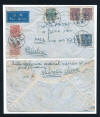|
A Memorable Piece of Mail
A
philatelist, interested in Judaica, yours truly comes across once in a
while with an interesting historic letter or a canceled envelope mailed
from an exotic part of the world, bearing a Jewish background.
One such item I recently discovered and acquired from an auction house
was an envelope mailed from Shanghai
in 1948 by, then Chief Rabbi Meir Ashkenazi, spiritual leader of the
former Russian community in
Shanghai.
The five stamps on the envelop with a portrait of Sun Yan-sen were
issued by the former Republic of China (ROC) in the year 1945 and 1947,
a time when a large contingent of Jewish refugees from Europe and
Central Asia were still living in Shanghai. As a reminder, the ROC
governed all of China before it lost control of the mainland in
1949 to the People’s Republic of China (PRC).
The first wave of Jewish migration to Shanghai
(1843-1920) consisted of Sephardic Jews from Baghdad
and Bombay.
Rabbi Ashkenazi, whose name appears on the return address of the
envelope, takes us back to the second wave (1920-1937), marked by the
migration of thousands of Russian Jews that fled the pogroms in Russia
and came via North-east China to Shanghai.
Rabbi Ashkenazi is remembered as a legendary figure by most
Shanghailanders (refugees that lived during the war years in Shanghai). Before and
during World War II, he spearheaded relief efforts for thousands of
European Jews who had taken refuge in
Shanghai.
 He
was in the forefront of all humanitarian Jewish communal activities,
both religious and secular. He
was in the forefront of all humanitarian Jewish communal activities,
both religious and secular.
One of the first things he did was to organize a building committee for
a new synagogue, the rented quarters having become too small for the
growing Ashkenazi congregation in
Shanghai. His efforts came to fruition in 1927
when the Ohel Moishe congregation moved to it new home at
62 Changyang Road, formerly
Ward Road. The complex housed the Talmud
Torah and Yeshiva both supported by the Russian Ashkenazi Jews and
headed by Rabbi Ashkenazi. They were well attended by students from all
the elements of Shanghai,
both religious and non-religious, with a new pair of leather shoes
awaiting many of the needy students every year as a reward for attending
regularly afternoon Hebrew classes. Matzos were also baked on the
premises and distributed during Passover to families in the Hongkew
Ghetto.
In 1928, the Russian Jews invited Rabbi Ashkenazi who was a member of
the Chabad-Lubavich movement, and the first Lubavitch rabbi in Shanghai, to lead their
community. He accepted and retained the position until his departure to New York in 1949.
The return address on the backside of the envelop shows that the Rabbi
may have resided on the street called Cardinal Mercier in the Shanghai upscale French Town.
Most of the better class among the Russian Jews and others were living
in that part of Shanghai.
After the Proclamation by the Japanese authorities was announced stating
that all stateless Jews had to move into the “Designated Area”, the
poorer section of Shanghai,
those that arrived prior to 1937 and not yet declared stateless, were
exempt. Among those were Rabbi Ashkenazi and the Jewish entrepreneurs
who were prospering in Shanghai
long before that time.
By the end of the war, Rabbi Ashkenazi was one of
approximately 24,000 Jews living in
Shanghai. The majority were from the third wave
of migration (1938-1952) that had escaped from persecution in
Europe. With the founding of the People’s Republic of
China
in 1949, the Jewish community dwindled, with many emigrating to Israel, the US,
and
Australia,
Reference:
Shanghai
Jewish Center, a project of Chabad
The Jewish Federation of Greater
Washington
Kranzler,
Shanghai,
1938-1945, Japanese,
Nazis & Jews
|
 He
was in the forefront of all humanitarian Jewish communal activities,
both religious and secular.
He
was in the forefront of all humanitarian Jewish communal activities,
both religious and secular.